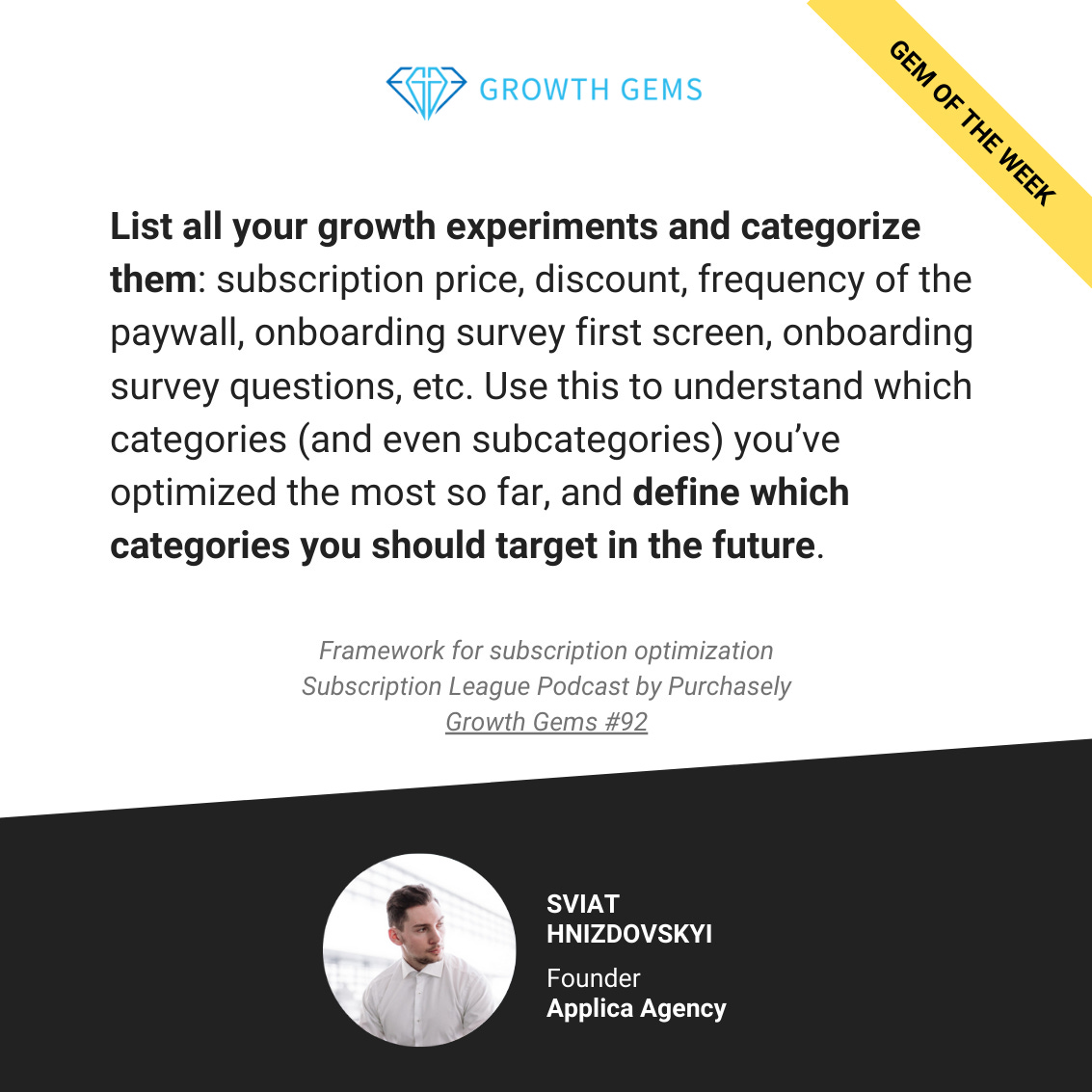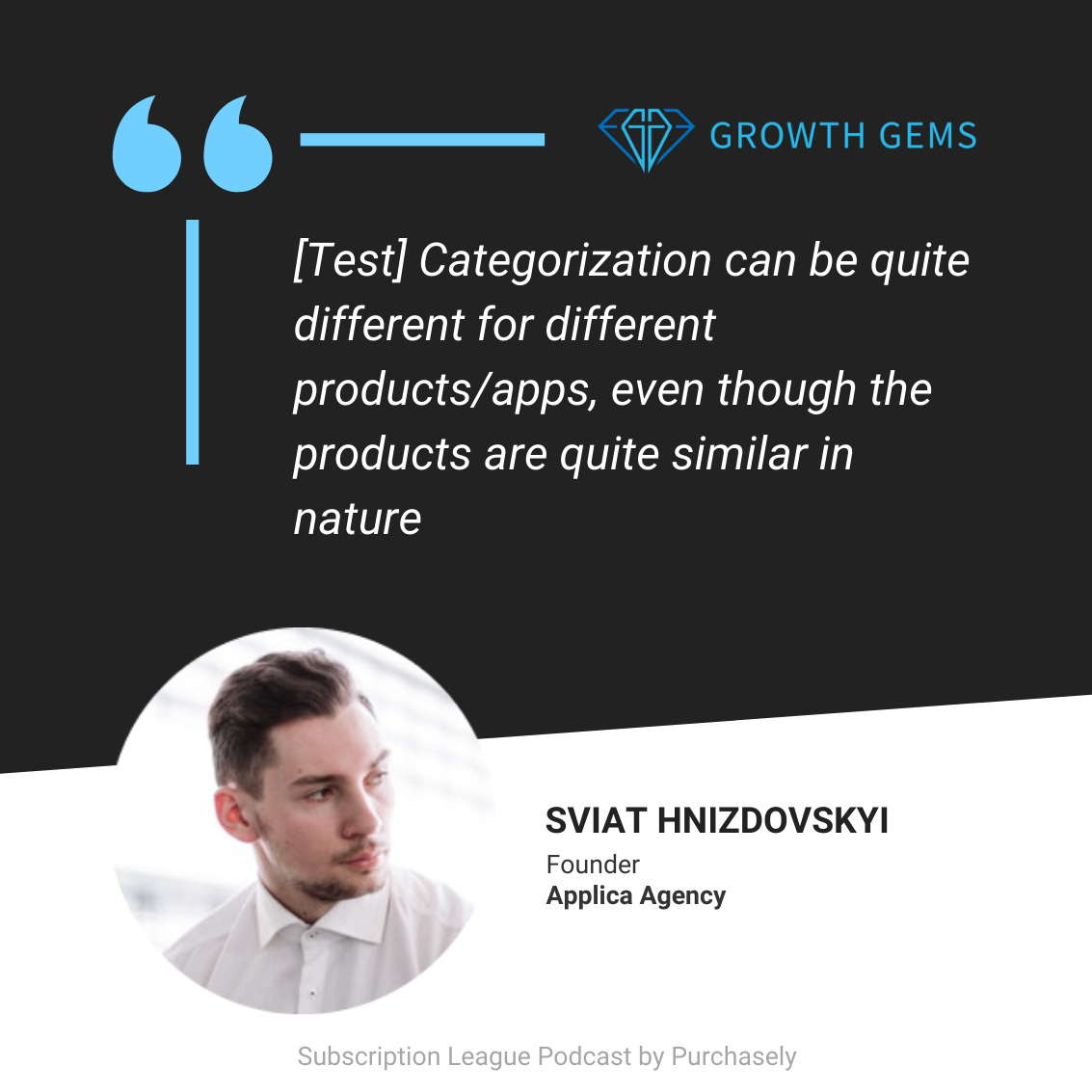💎 Growth Gems #92: Strategy and Monetization
Hey,
This week, I NEED YOUR HELP.
For the last 3 years, I’ve been putting a lot of love, time, and effort into Growth Gems. I want to make it as valuable as possible, as well as sustainable!
Please take 3 minutes to fill up this survey 🙏
Now that this is done (right??), onto this week’s gems:
These insights come from Sviat Hnizdovskyi and Nico Wittenborn.
Enjoy!
🥇 TOP GEM OF THE WEEK
Monetization: categorizing experiments, prioritization
I first heard Sviat Hnizdovskyi (Founder at Applica Agency) on a podcast episode by Adapty and featured the main insights in Growth Gems #80. He then shared more gems on the ironSource podcast (cf. Growth Gems #84).
This time, he talks with Olivier Destrebecq (freelance at Northmill) and Jeff Grang (Co-founder at Purchasely) on the episode Framework for subscription optimization of Purchasely’s Subscription League podcast.
This is a good reminder to keep track of experiments and look out for diminishing returns!
💎 List all your growth experiments and categorize them: subscription price, discount, frequency of the paywall, onboarding survey first screen, onboarding survey questions, etc. Use this to understand which categories (and even subcategories) you’ve optimized the most so far, and define which categories you should target in the future.
Sviat Hnizdovskyi (CEO at Applica)
at 08:20
⛏️ Going Deeper: check out Applica’s Experiment History Review Framework article (and the following gems) for more details.
💎 For each test, list the LTV change you’ve had per variant. Then, sort categories of tests per average LTV impact. This helps you understand how impactful a category of tests has been, how promising it might be, and to spot bottlenecks and low-hanging fruits.
Sviat Hnizdovskyi (CEO at Applica)
at 10:00
🤔 My 2 cents: initially, you won’t have the LTV for new tests, so it might be interesting to also keep track of the initial revenue per user. That’s actually what Sviat has in his examples:
💎 When it comes to pricing, track the specific effect of a/b tests by OS and country tier because prices (and price changes impact) can vary a lot for each OS/tier. Example: tier 1, US, and all other countries.
Sviat Hnizdovskyi (CEO at Applica)
at 15:25
💎 Keep track of diminishing returns as you conduct tests in a category. When you see diminishing returns in a category:
Start revisiting some of your assumptions, and think about bigger bets
Consider switching to another category
Sviat Hnizdovskyi (CEO at Applica)
at 17:20
⛏️ Going Deeper: Sviat shared that this framework can also be applied to retention-focused metrics, product engagement metrics, etc.
💎 A strategic decision you need to ask yourself: how “aggressive” you want to be with monetization and the impact you’re willing to have on retention.
Sviat Hnizdovskyi (CEO at Applica)
at 20:20
💎 Firebase is not the worst tool when it comes to the randomization for your a/b test, but it’s unreliable when it comes to the ARPPU results because it does not allow you to take into account what happens after the test or project LTV.
Sviat Hnizdovskyi (CEO at Applica)
at 23:50
💎 People are tired of long onboardings. Consider testing a shorter initial survey, then offering a longer survey later in the product.
Sviat Hnizdovskyi (CEO at Applica)
at 28:05
🤔 My 2 cents: are they really tired of it, though? Worth testing!
Strategy: evaluating subscription apps
My favorite insights usually come from growth practitioners.
But it’s also valuable to understand the perspective of VC/investors.
Nico Wittenborn (Investor at Adjacent) has invested in subscription apps (Photoroom, Opal, and more) as well as the companies powering them (RevenueCat, Superwall, UXCam).
In his appearance on the 20VC podcast, he explains why he likes the consumer subscription model and how he evaluates subscription companies.
💎 The consumer subscription model has downsides but is also a new model for which we are just starting to see the fruits. Companies like Netflix and Spotify were pioneers and validated willingness to pay for subscriptions. This was not more than 11-12 years ago (the App Store launched 12 years ago), and significant revenue generation started only 5-6 years ago. We can now have confidence that subscription companies can bring multi-billion dollar outcomes.
Nico Wittenborn (Investor at Adjacent)
at 07:40
💎 Churn in consumer subscriptions is usually very high in the first year, but from the second year on, it is closer to SMB SaaS churn. One-year subscription retention should be 50% (some companies even have 80-90%).
Nico Wittenborn (Investor at Adjacent)
at 09:36
💎 Steer acquisition so you can recover your CAC within the first year. You need a very good strategic reason to go past this one-year payback.
Nico Wittenborn (Investor at Adjacent)
at 10:40
💎 Lower CACs are one of the benefits of the consumer subscription model. You don’t have to hire a huge sales force to sell your product. It’s more flexible, and you typically have a good amount of organic traffic.
Nico Wittenborn (Investor at Adjacent)
at 11:20
⛏️ Going Deeper: Nico shared that 50% of organic traffic is a good guideline. This guidance is more so companies don’t forget about their organic acquisition: sometimes you’ll need to have 60-80% of paid acquisition for some time if the unit economics are very good.
💎 You want to have some product components that accelerate paid acquisition: “the power of experience”. Examples: an actual feature, something you show people (e.g., Oura sleep story). Things really work when organic scales in lockstep with paid.
Nico Wittenborn (Investor at Adjacent)
at 12:00
💎 It’s surprising how little price sensitivity there is for really good products. The willingness to pay for a great product is increasing.
Nico Wittenborn (Investor at Adjacent)
at 13:58
💎 The number one indicator for conversions is how often users see the paywall. You don’t want to go overboard, but the paid conversion also sometimes activates the user: the fact of paying increases a user’s engagement.
Nico Wittenborn (Investor at Adjacent)
at 14:56
⛏️ Going Deeper: the “install to paywall” metric, or “percentage of users seeing the paywall” is something that comes back often. Jake Mor (CEO at Superwall) has probably been the most vocal about this, and I shared several great insights from one of his webinars in Growth Gems #65.
💎 You need to take advantage of an acquisition channel when it opens up, but you also need to invest in diversification and have the discipline to try and crack the next channel(s).
Nico Wittenborn (Investor at Adjacent)
at 16:08
💎 Subscription apps are a very cash-efficient way to get started, and a seed round can get you to tens of millions in revenue. But this is also usually just the first surface area of your product, and you can find other revenue sources. Example: Photoroom is a prosumer product that started on mobile; it’s popular in the US and emerging countries, and now the product is coming to the web, supports teams, and there is an API people pay for.
Nico Wittenborn (Investor at Adjacent)
at 16:44
💎 Don’t raise too much, too early, and on too much valuation. Also, you should only raise later rounds if you see those next chapters and levels of acceleration.
Nico Wittenborn (Investor at Adjacent)
at 18:45
💎 At Seed, you don’t need a board because you are chasing product-market fit, and the most valuable thing is to talk to other founders that have faced similar issues. From A series, it makes sense to have a board.
Nico Wittenborn (Investor at Adjacent)
at 25:16
💎 In the early stage, investing right is a lot about having a pretty unique perspective on something: an opinion that is not consensus-driven that is aligned with what you believe. Nothing happens overnight! Understanding the components of a breakthrough and the macro-changes allows you to understand the companies that will benefit in the next 10 years. It can be a technical component (e.g., OpenAI with chatGPT) or behavioral (Calm with meditation, Opal with screen time management).
Nico Wittenborn (Investor at Adjacent)
at 35:55
And before I leave, here is a quote on the CAC trap:
“in this ‘money doesn't grow on trees’ economy, where every dollar counts, the real hero is the velocity of the payback period” - Elena Verna (Growth Solopreneur)
See you next time. Stay curious!
⛏️ Sylvain
🔗 Sources:
Applica: Framework for subscription optimization: tips from behavioral science expert Sviat Hnizdovskyi on Purchasely’s Subscription League















